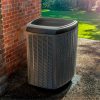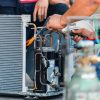 Troubleshooting Freon Loss in Air Conditioning Systems
Troubleshooting Freon Loss in Air Conditioning Systems
During the summer months, one common issue with air conditioning systems is a loss of freon. Unfortunately, many contractors simply add a few pounds of freon and consider the problem solved. However, this quick fix is neither the correct nor a lasting solution. In this article, we will outline the proper steps to address freon loss and ensure your air conditioner’s long-term functionality.
Understanding How Air Conditioning Systems Work
Air conditioning systems operate by utilizing a refrigerant, such as freon, to change its state and extract heat from the air. The refrigerant circulates within a sealed system, which ideally should never require replacement or recharging. During a proper installation, the contractor should perform a vacuum test on the system to check for any leaks. If a leak is detected, it needs to be located and repaired. This is where problems often arise, as inadequate installation practices can result in undetected leaks.
The Consequences of Freon Loss
Undetected leaks can go unnoticed for several years, and by the time the issue becomes apparent to the customer, the warranty on the product or installation may have expired. In such cases, when another contractor is called to investigate the problem, they often opt for a temporary fix by simply refilling the freon. This freon recharge service can cost anywhere from $350 to $675, and repeated recharges can lead to the customer spending more than the system’s worth. Moreover, low freon levels can cause damage to the compressor and lead to future complications.
The Proper Approach to Freon Loss
Resolving the issue of freon loss is straightforward, and following the steps outlined below will ensure a long-lasting solution and guarantee the proper functioning of your air conditioning system.
Step 1: Pressure Testing with Nitrogen
To detect the source of the leak, it is crucial to pressurize the system with nitrogen. By increasing the pressure, any leaks can be audibly detected. If the leak is found in the coils (either inside or outside), they should be replaced. Ideally, the leak will be in one of the original welds and can be easily repaired.
Step 2: Vacuum Testing
After the repair is completed, the system needs to undergo a vacuum test. This process involves creating a negative pressure within the system to remove non condensable substances and any moisture present. The vacuum should be held for at least an hour to check for any pressure loss. If no loss is observed, the system can be recharged to factory standards.
Contact An Expert
By following the correct procedures outlined above, you can effectively address freon loss in your air conditioning system. Taking the necessary steps to identify and repair leaks will ensure that your system operates optimally and eliminates the need for recurring freon recharges. It is essential to prioritize proper installation and regular maintenance to avoid costly repairs and potential damage to your compressor. For quality heating and cooling service in the Tampa Bay Area, rely on Velocity Air Conditioning, owned by Tyler Snyder, who has extensive experience in the industry.


 Troubleshooting Freon Loss in Air Conditioning Systems
Troubleshooting Freon Loss in Air Conditioning Systems




